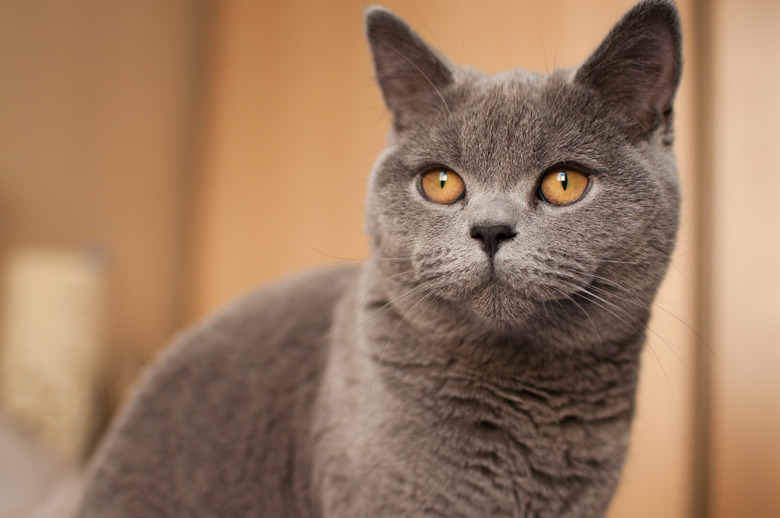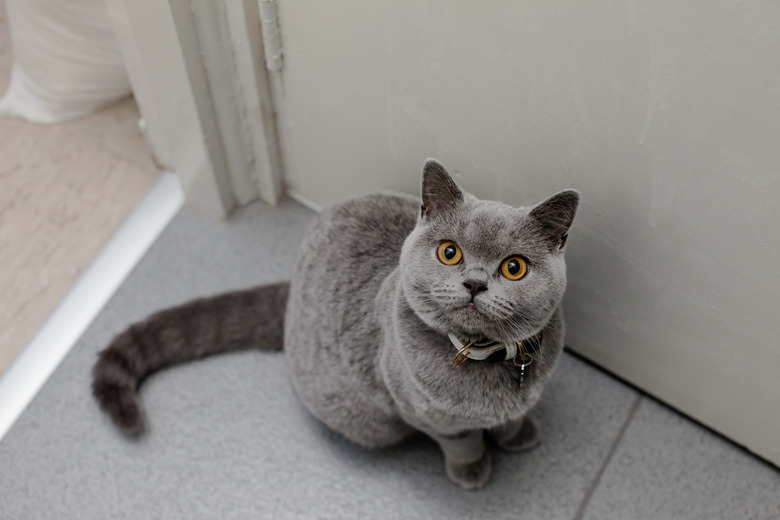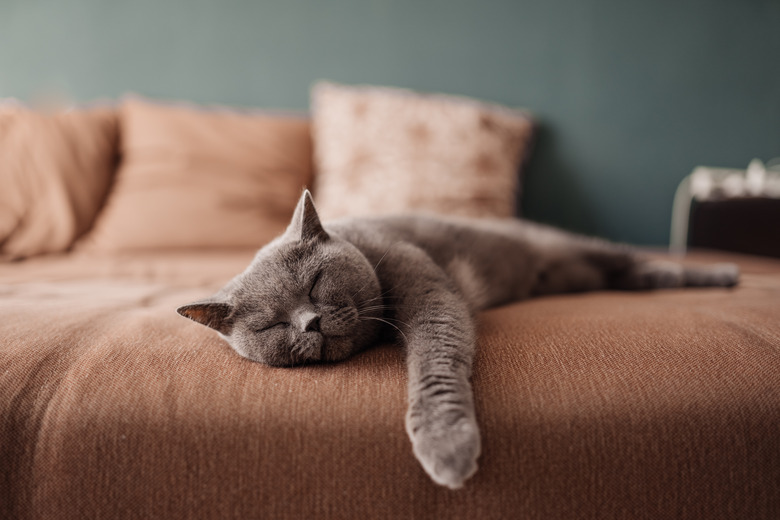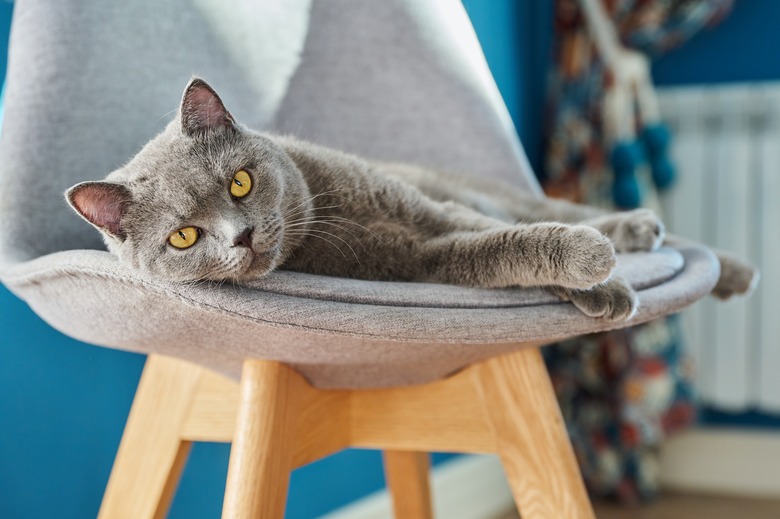British Shorthair Cat Breed Characteristics
British shorthair quick facts
British shorthair quick facts
Length: 12 – 16 inches
Weight: Females: 7 to 12 pounds, Males: 9 to 17 pounds
Lifespan: 12 to 20 years
Coat length: Short
Coloring: Blue is the most common coat color but the breed comes in many colors and patterns
Grooming needs: Low
Friendliness: Breed alone is not an accurate predictor of individual cats' personalities. However, British shorthair cats are generally regarded as affectionate and calm.
The British shorthair is an easygoing and affectionate cat. They are medium to large cats with plush, dense coats. These cats have compact bodies, broad chests, and round eyes staring out of a round head with chubby cheeks. It is no wonder British shorthair cats are sometimes described as resembling teddy bears. You may also recognize them from Lewis Carroll's "Alice in Wonderland" as it is believed the breed was an inspiration for the Cheshire cat character.
They are not lap cats nor are they high energy or high maintenance. These independent and intelligent cats enjoy lounging next to you and tend to get along with all members of the family. Before you commit to bringing a British shorthair kitten home, carefully consider the breed's personality and care requirements. Make sure they are a good fit for your household.
British shorthair cat history
British shorthair cat history
The British shorthair cat is believed to have originated from the cats that the Romans brought with them when they invaded Britain in the first century. These domestic street cats were bred with wildcats local to the area. Today's British shorthair cats retain the thick coat and stocky build that made their ancestors able to hunt and withstand the elements.
In the 19th century, cat breeder, Harrison Weir, began breeding cats. The breeding resulted in the blue color which explains its prevalence even today. Though the breed was nearly lost after both World War I and World War II. Fortunately, breeders were able to save the British shorthair breed by outcrossing to Persian, Russian blue, and Chartreux cats. The British longhair breed came from the crossing of British shorthair cats to Persians.
The breed was originally registered as British blue with the American Cat Association. While the blue coat color is still the most common, British shorthair cats come in a variety of colors and patterns including:
- bi-color
- calico
- tabby
- tortoiseshell
The British shorthair breed was accepted by the International Cat Association (TICA) in 1979 and by the Cat Fanciers' Association (CFA) in 1980.
British shorthair cat personality
British shorthair cat personality
If you are looking for an intelligent and laid-back family cat to join your family, the British shorthair may be the cat for you. Males tend to be more outgoing than female cats. The breed tends to be very adaptable to different situations and most cats get along well with other pets.
The breed is quite affectionate and they enjoy your company. Yet they are also quite independent and seldom demand attention. They don't generally enjoy being carried or sitting in your lap. If you have small children, make sure to teach them not to pick up the cat and how to interact with the cat safely.
British shorthairs also don't have a high activity level, but they do enjoy playing and jumping. However, they are not as athletic or acrobatic as some other breeds. At times they can even be called clumsy.
British shorthair cat lifespan and health issues
British shorthair cat lifespan and health issues
The British shorthair cat breed is generally very healthy with few genetic health problems. Healthy cats can live well into their teens. Obesity can be a problem later in life as these easygoing cats don't tend to be as active. If you notice your cat gaining weight, work with your veterinarian to adjust their diet. Make it a point to spend time playing with the cat each day to make sure they are getting some exercise.
As with many other cats, the breed is at risk of hypertrophic cardiomyopathy, a type of heart disease that causes a thickening of the heart wall. Responsible breeders will screen their pedigreed cats with an echocardiogram for the disease before breeding them. Unfortunately, this condition does not always appear early in life. Therefore, it is important for your cat to have regular veterinary examinations.
British shorthair cat grooming and care
British shorthair cat grooming and care
The British shorthair's coat is fairly low maintenance and easy to groom. They have a thick coat but generally, you only need to brush them once or twice per week. The cats do tend to shed a lot, especially in the spring months. More frequent brushing can help reduce the amount of loose hair you find on your floors and furniture. In addition to regular brushing:
- check and trim the cat's nails about twice per month
- brush the cat's teeth with a veterinarian-approved pet toothpaste
- clean the cat's ears
Feed the cats high-quality commercial cat food, preferably wet food, twice per day. Make sure they have fresh drinking water available at all times. Schedule regular check-ups with the veterinarian and make sure the cat is up-to-date on their recommended vaccinations.
Welcoming a new cat into your home
Welcoming a new cat into your home
Welcoming a new kitten into your home is an exciting event. Make sure everything goes smoothly by preparing the house before your cat arrives. Cat-proof the home by removing poisonous plants and anything else that may be harmful to your cat. Then, set up a single room with everything your new cat may need including:
- food and water
- litter box
- cat toys
- cat tree
- scratching post
When your new British shorthair kitten first arrives, confine them to that single room. That way, they have a calm place to adjust to the new environment. Allow the cat to explore at their own pace. It is a good idea to sit and talk to them so that they can get to know you.
Keep in mind that British shorthair cats don't like being carried. Allow the cat to come to you when they are ready and offer plenty of positive reinforcement. If you have children or other pets in the household, this is a good time to make introductions. When your new cat is comfortable, you can open up the room so that they can explore the rest of the house and join your family.



